Adolf Hiter: Rise to Power, Impact & Death | HISTORY (original) (raw)
Early Life
Adolf Hitler was born on April 20, 1889, in Braunau am Inn, a small Austrian town near the Austro-German frontier. After his father, Alois, retired as a state customs official, young Adolf spent most of his childhood in Linz, the capital of Upper Austria.
Not wanting to follow in his father’s footsteps as a civil servant, he began struggling in secondary school and eventually dropped out. Alois died in 1903, and Adolf pursued his dream of being an artist, though he was rejected from Vienna’s Academy of Fine Arts.
After his mother, Klara, died in 1908, Hitler moved to Vienna, where he pieced together a living painting scenery and monuments and selling the images. Lonely, isolated and a voracious reader, Hitler became interested in politics during his years in Vienna, and developed many of the ideas that would shape Nazi ideology.
Military Career of Adolf Hitler
In 1913, Hitler moved to Munich, in the German state of Bavaria. When World War I broke out the following summer, he successfully petitioned the Bavarian king to be allowed to volunteer in a reserve infantry regiment.
Deployed in October 1914 to Belgium, Hitler served throughout the Great War and won two decorations for bravery, including the rare Iron Cross First Class, which he wore to the end of his life.
Hitler was wounded twice during the conflict: He was hit in the leg during the Battle of the Somme in 1916, and temporarily blinded by a British gas attack near Ypres in 1918. A month later, he was recuperating in a hospital at Pasewalk, northeast of Berlin, when news arrived of the armistice and Germany’s defeat in World War I.
Like many Germans, Hitler came to believe the country’s devastating defeat could be attributed not to the Allies, but to insufficiently patriotic “traitors” at home—a myth that would undermine the post-war Weimar Republic and set the stage for Hitler’s rise.
Nazi Party
After Hitler returned to Munich in late 1918, he joined the small German Workers’ Party, which aimed to unite the interests of the working class with a strong German nationalism. His skilled oratory and charismatic energy helped propel him in the party’s ranks, and in 1920 he left the army and took charge of its propaganda efforts.
In one of Hitler’s strokes of propaganda genius, the newly renamed National Socialist German Workers Party, or Nazi Party, adopted a version of the swastika—an ancient sacred symbol of Hinduism, Jainism and Buddhism—as its emblem. Printed in a white circle on a red background, Hitler’s swastika would take on terrifying symbolic power in the years to come.
By the end of 1921, Hitler led the growing Nazi Party, capitalizing on widespread discontent with the Weimar Republic and the punishing terms of the Versailles Treaty. Many dissatisfied former army officers in Munich would join the Nazis, notably Ernst Röhm, who recruited the “strong arm” squads—known as the Sturmabteilung (SA)—which Hitler used to protect party meetings and attack opponents.
Beer Hall Putsch
On the evening of November 8, 1923, members of the SA and others forced their way into a large beer hall where another right-wing leader was addressing the crowd. Wielding a revolver, Hitler proclaimed the beginning of a national revolution and led marchers to the center of Munich, where they got into a gun battle with police.
Hitler fled quickly, but he and other rebel leaders were later arrested. Even though it failed spectacularly, the Beer Hall Putsch established Hitler as a national figure, and (in the eyes of many) a hero of right-wing nationalism.
'Mein Kampf'
Tried for treason, Hitler was sentenced to five years in prison, but would serve only nine months in the relative comfort of Landsberg Castle. During this period, he began to dictate the book that would become "Mein Kampf" (“My Struggle”), the first volume of which was published in 1925.
In it, Hitler expanded on the nationalistic, anti-Semitic views he had begun to develop in Vienna in his early twenties, and laid out plans for the Germany—and the world—he sought to create when he came to power.
Hitler would finish the second volume of "Mein Kampf" after his release, while relaxing in the mountain village of Berchtesgaden. It sold modestly at first, but with Hitler’s rise it became Germany’s best-selling book after the Bible. By 1940, it had sold some 6 million copies there.
Hitler’s second book, “The Zweites Buch,” was written in 1928 and contained his thoughts on foreign policy. It was not published in his lifetime due to the poor initial sales of “Mein Kampf.” The first English translations of “The Zweites Buch” did not appear until 1962 and was published under the title “Hitler's Secret Book.”
Obsessed with race and the idea of ethnic “purity,” Hitler saw a natural order that placed the so-called “Aryan race” at the top.
For him, the unity of the Volk (the German people) would find its truest incarnation not in democratic or parliamentary government, but in one supreme leader, or Führer.
"Mein Kampf" also addressed the need for Lebensraum (or living space): In order to fulfill its destiny, Germany should take over lands to the east that were now occupied by “inferior” Slavic peoples—including Austria, the Sudetenland (Czechoslovakia), Poland and Russia.
The Schutzstaffel (SS)
By the time Hitler left prison, economic recovery had restored some popular support for the Weimar Republic, and support for right-wing causes like Nazism appeared to be waning.
Over the next few years, Hitler laid low and worked on reorganizing and reshaping the Nazi Party. He established the Hitler Youth to organize youngsters, and created the Schutzstaffel (SS) as a more reliable alternative to the SA.
Members of the SS wore black uniforms and swore a personal oath of loyalty to Hitler. (After 1929, under the leadership of Heinrich Himmler, the SS would develop from a group of some 200 men into a force that would dominate Germany and terrorize the rest of occupied Europe during World War II.)
Eva Braun
Hitler spent much of his time at Berchtesgaden during these years, and his half-sister, Angela Raubal, and her two daughters often joined him. After Hitler became infatuated with his beautiful blonde niece, Geli Raubal, his possessive jealousy apparently led her to commit suicide in 1931.
Devastated by the loss, Hitler would consider Geli the only true love affair of his life. He soon began a long relationship with Eva Braun, a shop assistant from Munich, but refused to marry her.
The worldwide Great Depression that began in 1929 again threatened the stability of the Weimar Republic. Determined to achieve political power in order to affect his revolution, Hitler built up Nazi support among German conservatives, including army, business and industrial leaders.
The Third Reich
In 1932, Hitler ran against the war hero Paul von Hindenburg for president, and received 36.8 percent of the vote. With the government in chaos, three successive chancellors failed to maintain control, and in late January 1933 Hindenburg named the 43-year-old Hitler as chancellor, capping the stunning rise of an unlikely leader.
January 30, 1933 marked the birth of the Third Reich, or as the Nazis called it, the “Thousand-Year Reich” (after Hitler’s boast that it would endure for a millennium).
Reichstag Fire
Though the Nazis never attained more than 37 percent of the vote at the height of their popularity in 1932, Hitler was able to grab absolute power in Germany largely due to divisions and inaction among the majority who opposed Nazism.
After a devastating fire at Germany’s parliament building, the Reichstag, in February 1933—possibly the work of a Dutch communist, though later evidence suggested Nazis set the Reichstag fire themselves—Hitler had an excuse to step up the political oppression and violence against his opponents.
On March 23, the Reichstag passed the Enabling Act, giving full powers to Hitler and celebrating the union of National Socialism with the old German establishment (i.e., Hindenburg).
That July, the government passed a law stating that the Nazi Party “constitutes the only political party in Germany,” and within months all non-Nazi parties, trade unions and other organizations had ceased to exist.
His autocratic power now secure within Germany, Hitler turned his eyes toward the rest of Europe.
In 1933, Germany was diplomatically isolated, with a weak military and hostile neighbors (France and Poland). In a famous speech in May 1933, Hitler struck a surprisingly conciliatory tone, claiming Germany supported disarmament and peace.
But behind this appeasement strategy, the domination and expansion of the Volk remained Hitler’s overriding aim.
By early the following year, he had withdrawn Germany from the League of Nations and begun to militarize the nation in anticipation of his plans for territorial conquest.
Night of the Long Knives
On June 29, 1934, the infamous Night of the Long Knives, Hitler had Röhm, former Chancellor Kurt von Schleicher and hundreds of other problematic members of his own party murdered, in particular troublesome members of the SA.
When the 86-year-old Hindenburg died on August 2, military leaders agreed to combine the presidency and chancellorship into one position, meaning Hitler would command all the armed forces of the Reich.
Persecution of Jews
On September 15, 1935, passage of the Nuremberg Laws deprived Jews of German citizenship, and barred them from marrying or having relations with persons of “German or related blood.”
Though the Nazis attempted to downplay its persecution of Jews in order to placate the international community during the 1936 Berlin Olympics (in which German-Jewish athletes were not allowed to compete), additional decrees over the next few years disenfranchised Jews and took away their political and civil rights.
In addition to its pervasive anti-Semitism, Hitler’s government also sought to establish the cultural dominance of Nazism by burning books, forcing newspapers out of business, using radio and movies for propaganda purposes and forcing teachers throughout Germany’s educational system to join the party.
Much of the Nazi persecution of Jews and other targets occurred at the hands of the Geheime Staatspolizei (GESTAPO), or Secret State Police, an arm of the SS that expanded during this period.
Outbreak of World War II
In March 1936, against the advice of his generals, Hitler ordered German troops to reoccupy the demilitarized left bank of the Rhine.
Over the next two years, Germany concluded alliances with Italy and Japan, annexed Austria and moved against Czechoslovakia—all essentially without resistance from Great Britain, France or the rest of the international community.
Once he confirmed the alliance with Italy in the so-called “Pact of Steel” in May 1939, Hitler then signed a non-aggression pact with the Soviet Union. On September 1, 1939, Nazi troops invaded Poland, finally prompting Britain and France to declare war on Germany.
Blitzkrieg
After ordering the occupation of Norway and Denmark in April 1940, Hitler adopted a plan proposed by one of his generals to attack France through the Ardennes Forest. The blitzkrieg (“lightning war”) attack began on May 10; Holland quickly surrendered, followed by Belgium.
German troops made it all the way to the English Channel, forcing British and French forces to evacuate en masse from Dunkirk in late May. On June 22, France was forced to sign an armistice with Germany.
Hitler had hoped to force Britain to seek peace as well, but when that failed he went ahead with his attacks on that country, followed by an invasion of the Soviet Union in June 1941.
After the attack on Pearl Harbor that December, the United States declared war on Japan, and Germany’s alliance with Japan demanded that Hitler declare war on the United States as well.
At that point in the conflict, Hitler shifted his central strategy to focus on breaking the alliance of his main opponents (Britain, the United States and the Soviet Union) by forcing one of them to make peace with him.
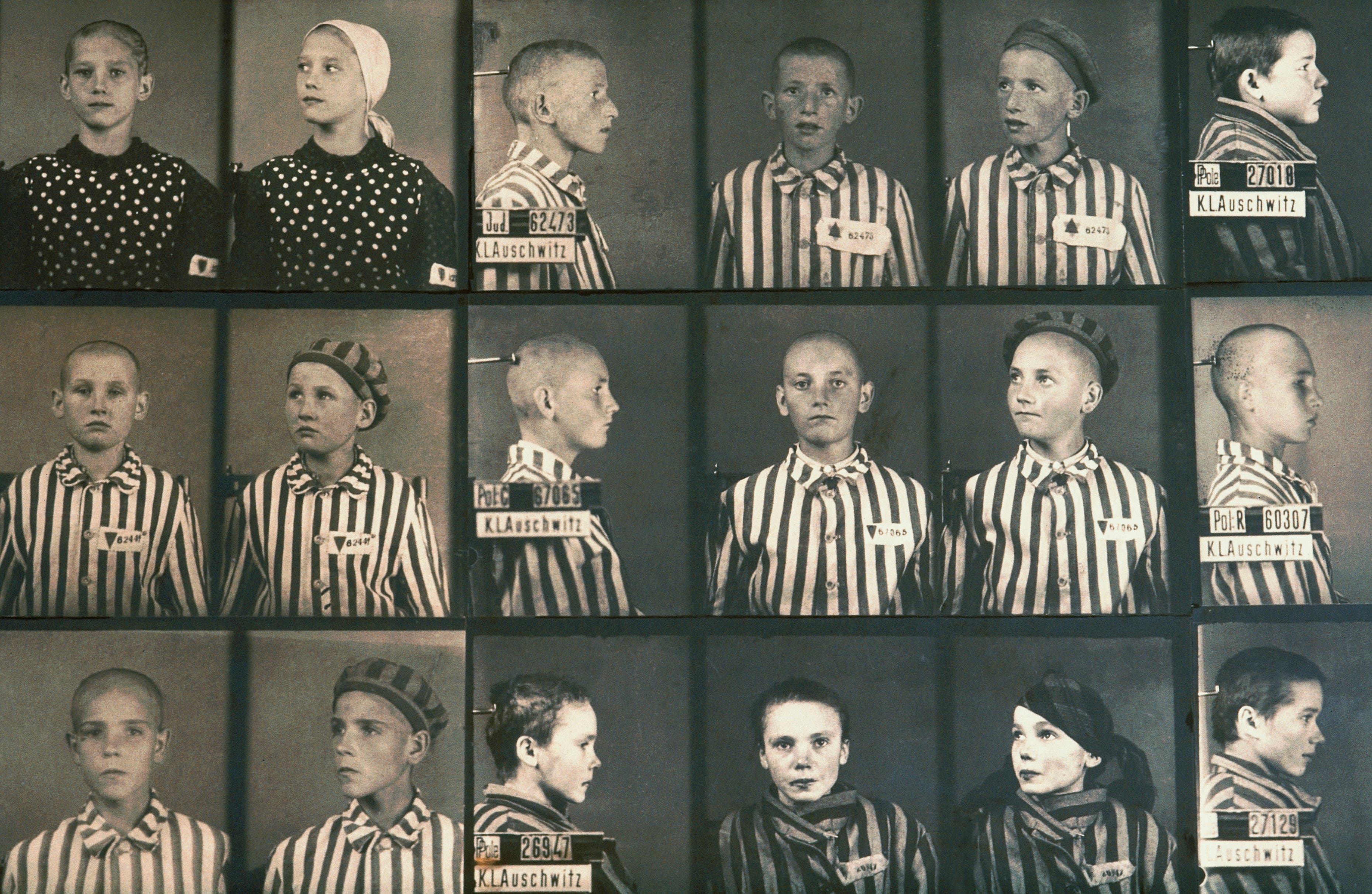
Adolf Hitler and the Nazi regime set up networks of concentration camps before and during World War II to carry out a plan of genocide. Hitler's "final solution" called for the eradication of Jewish people and other "undesirables," including homosexuals, Roma and people with disabilities. The children pictured here were held at the Auschwitz concentration camp in Nazi-occupied Poland.
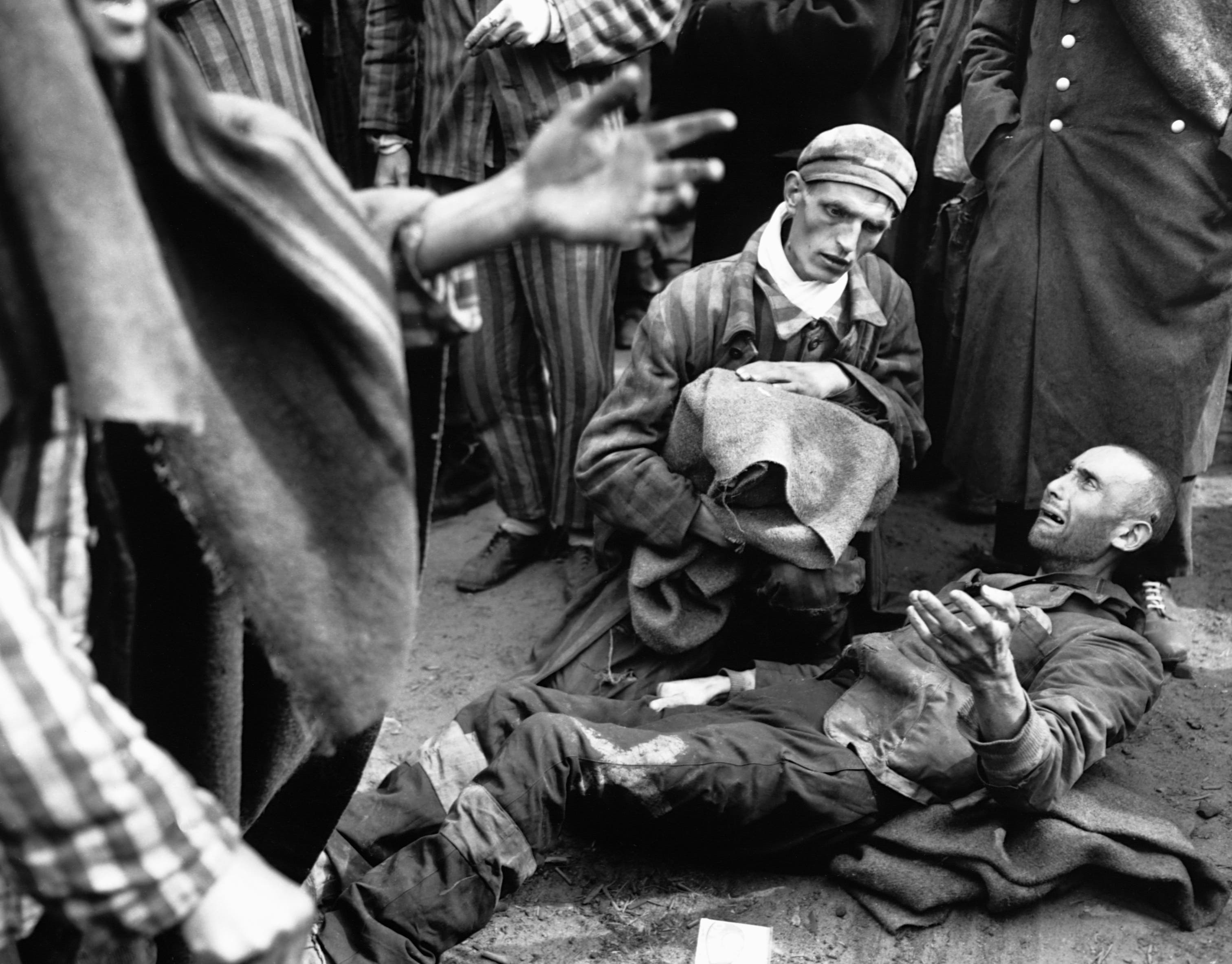
Survivors at the Wobbelin concentration camp in northern Germany were found by the U.S. Ninth Army in May 1945. Here, one man breaks out in tears when he finds he is not leaving with the first group to be taken to the hospital.

Survivors at Buchenwald concentration camp are shown in their barracks after liberation by the Allies in April 1945. The camp was located in a wooded area in Ettersberg, Germany, just east of Weimar. Elie Wiesel, the Nobel Prize winning author of Night, is on the second bunk from the bottom, seventh from the left.
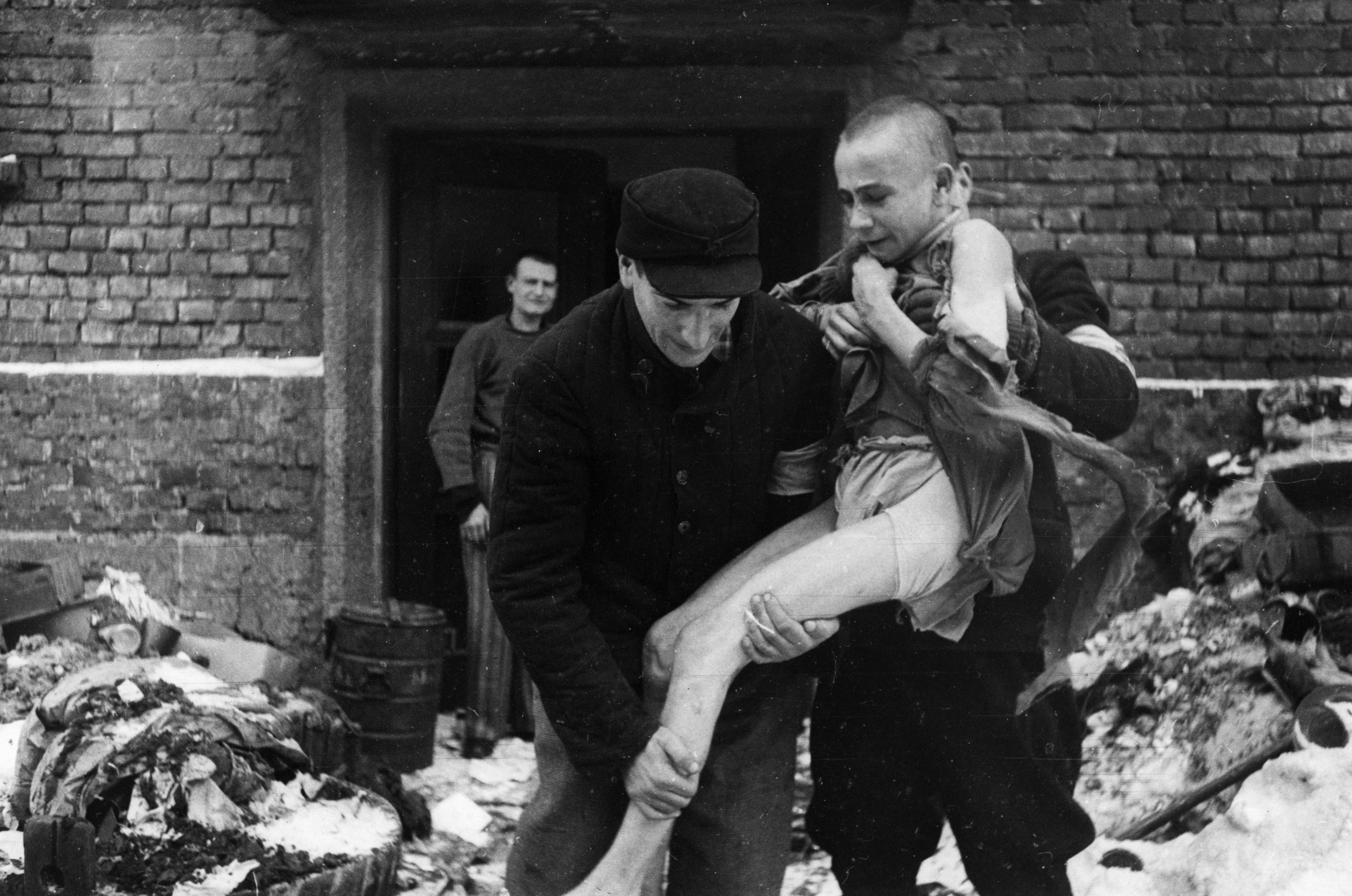
Fifteen-year-old Ivan Dudnik was brought to Auschwitz from his home in the Oryol region of Russia by the Nazis. While being rescued after the liberation of Auschwitz, he had reportedly gone insane after witnessing mass horrors and tragedies at the camp.

Allied troops are shown in May 1945 discovering Holocaust victims in a railroad car that did not arrive at its final destination. It was believed this car was on a journey to the Wobbelin concentration camp near Ludwigslust, Germany where many of the prisoners died along the way.
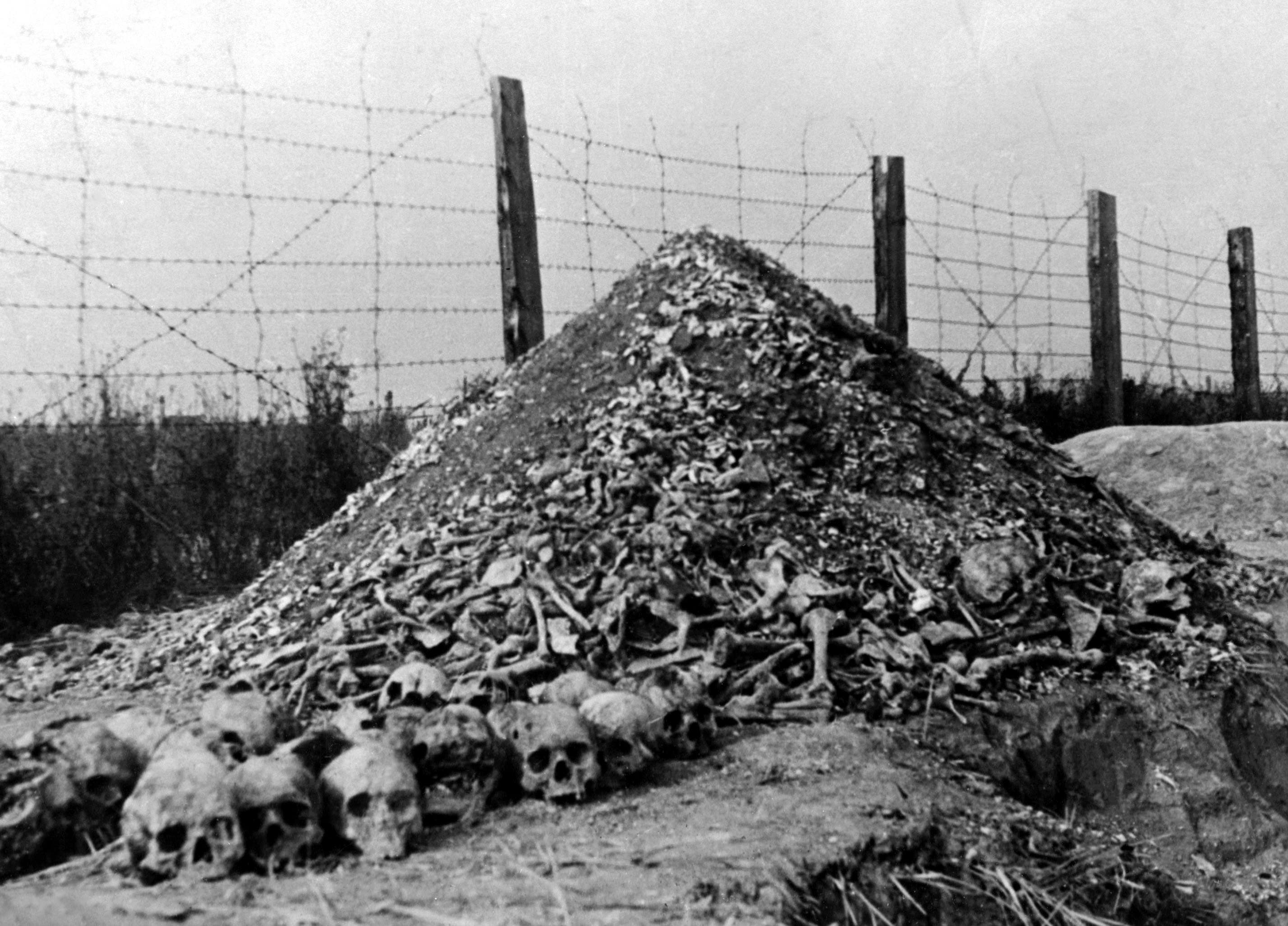
A total of 6 million lives were lost as a result of the Holocaust. Here, a pile of human bones and skulls is seen in 1944 at the Majdanek concentration camp in the outskirts of Lublin, Poland. Majdanek was the second largest death camp in Nazi-occupied Poland after Auschwitz.
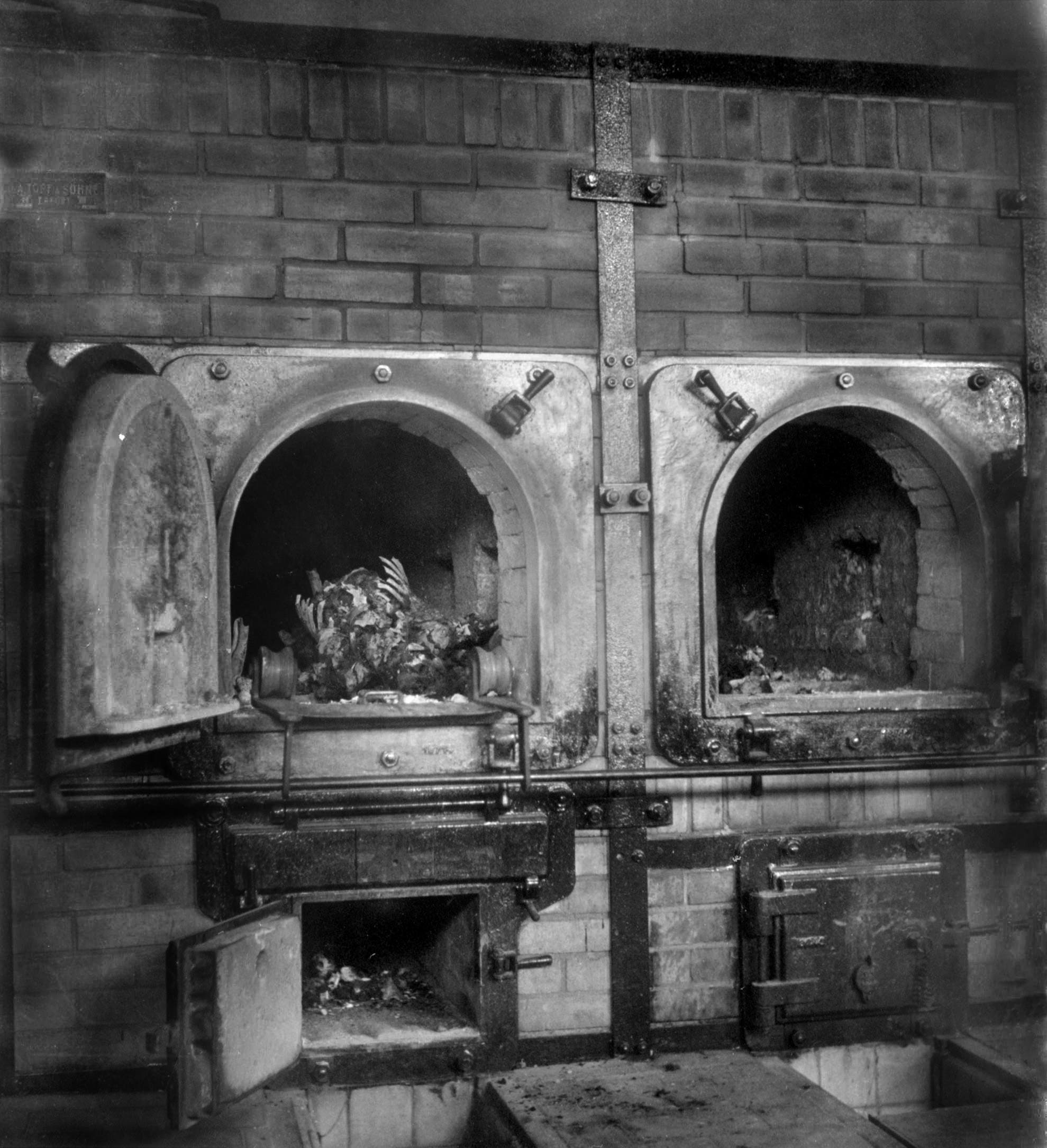
A body is seen in a crematory oven in the Buchenwald concentration camp near Weimar, Germany in April 1945. This camp not only imprisoned Jews, it also included Jehovah’s Witnesses, gypsies, German military deserters, prisoners of war, and repeat criminals.
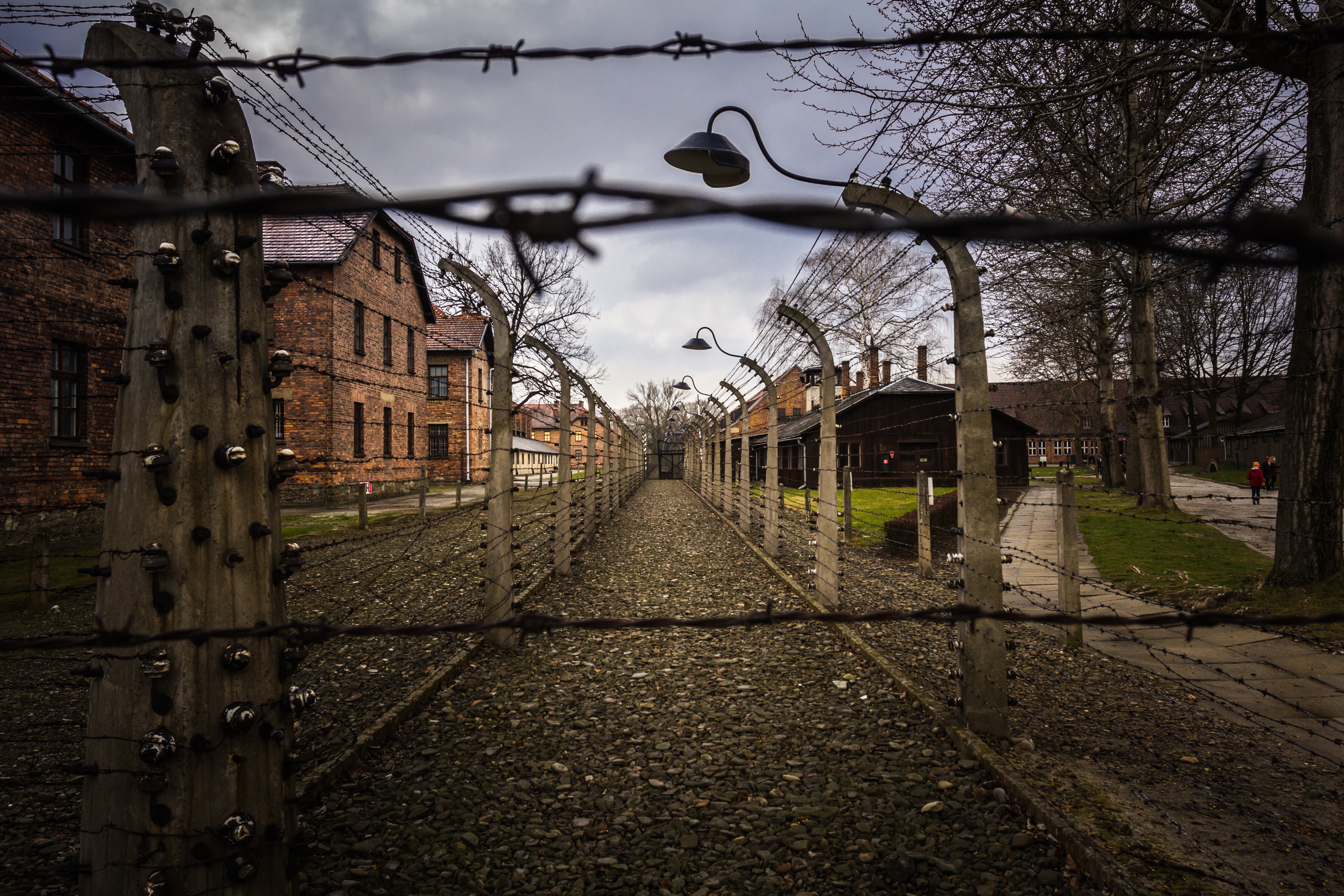
Auschwitz camp, as seen in April 2015. Nearly 1.3 million people were deported to the camp and more than 1.1 million perished. Although Auschwitz had the highest death rate, it also had the highest survival rate of all the killing centers.

Prosthetic legs and crutches are a part of a permanent exhibition in the Auschwitz Museum. On July 14, 1933, the Nazi government enforced the “Law for Prevention of Progeny with Hereditary Diseases” in their attempt to achieve a purer “master” race. This called for the sterilization of people with mental illness, deformities, and a variety of other disabilities. Hitler later took it to more extreme measures and between 1940 and 1941, 70,000 disabled Austrians and Germans were murdered. Some 275,000 disabled people were murdered by the end of the war.
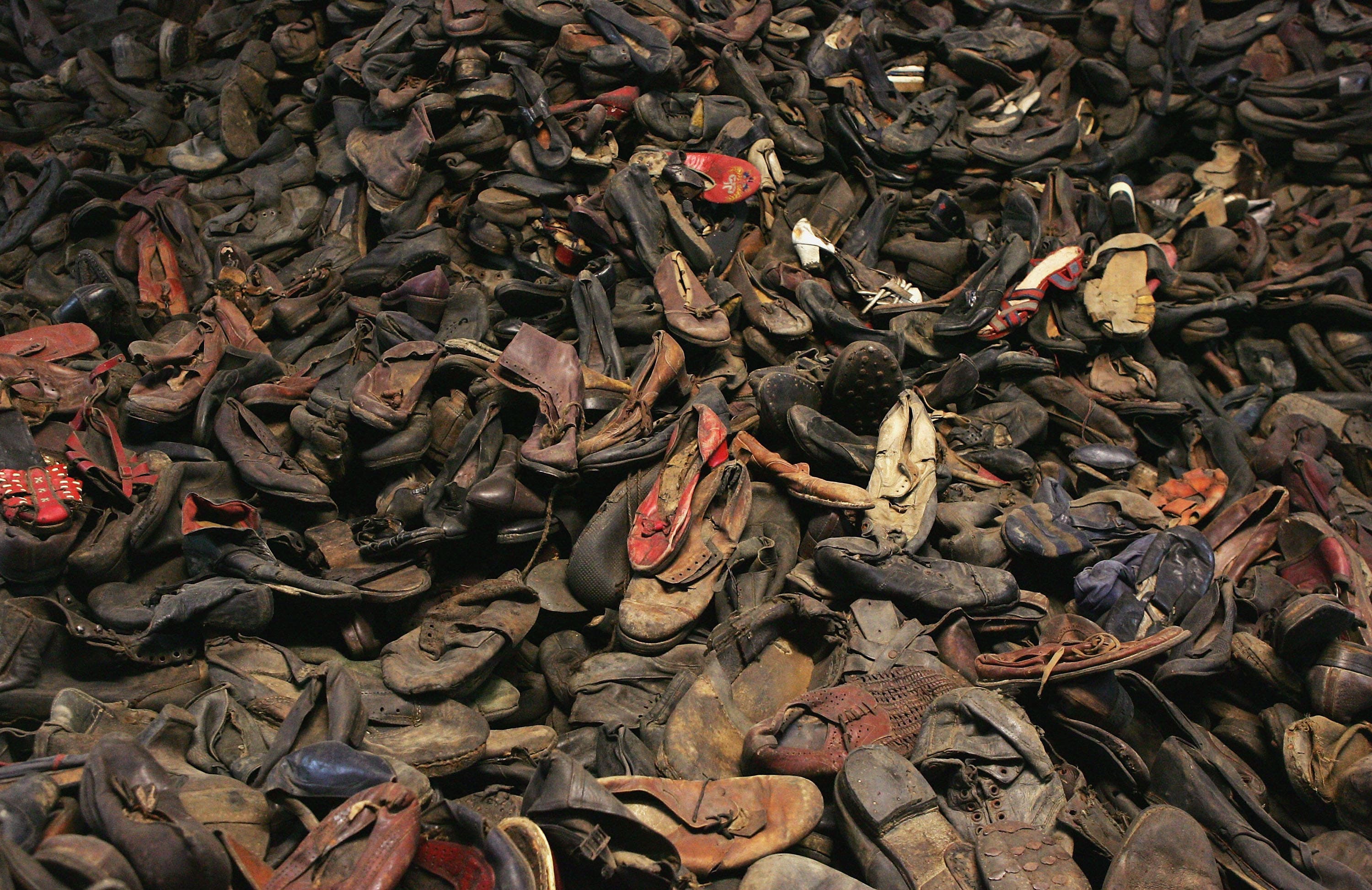
A pile of footwear are also a part of the Auschwitz Museum.
1 / 10: DeAgostini/Getty Images
Concentration Camps
Beginning in 1933, the SS had operated a network of concentration camps, including a notorious camp at Dachau, near Munich, to hold Jews and other targets of the Nazi regime.
After war broke out, the Nazis shifted from expelling Jews from German-controlled territories to exterminating them. Einsatzgruppen, or mobile death squads, executed entire Jewish communities during the Soviet invasion, while the existing concentration-camp network expanded to include death camps like Auschwitz-Birkenau in occupied Poland.
In addition to forced labor and mass execution, certain Jews at Auschwitz were targeted as the subjects of horrific medical experiments carried out by eugenicist Josef Mengele, known as the “Angel of Death.” Mengele’s experiments focused on twins and exposed 3,000 child prisoners to disease, disfigurement and torture under the guise of medical research.
Though the Nazis also imprisoned and killed Catholics, homosexuals, political dissidents, Roma (gypsies) and the disabled, above all they targeted Jews—some 6 million of whom were killed in German-occupied Europe by war’s end.
End of World War II
With defeats at El-Alamein and Stalingrad, as well as the landing of U.S. troops in North Africa by the end of 1942, the tide of the war turned against Germany.
As the conflict continued, Hitler became increasingly unwell, isolated and dependent on medications administered by his personal physician.
Several attempts were made on his life, including one that came close to succeeding in July 1944, when Col. Claus von Stauffenberg planted a bomb that exploded during a conference at Hitler’s headquarters in East Prussia.
Within a few months of the successful Allied invasion of Normandy in June 1944, the Allies had begun liberating cities across Europe. That December, Hitler attempted to direct another offensive through the Ardennes, trying to split British and American forces.
But after January 1945, he holed up in a bunker beneath the Chancellery in Berlin. With Soviet forces closing in, Hitler made plans for a last-ditch resistance before finally abandoning that plan.
How Did Adolf Hitler Die?
At midnight on the night of April 28-29, Hitler married Eva Braun in the Berlin bunker. After dictating his political testament, Hitler shot himself in his suite on April 30; Braun took poison. Their bodies were burned according to Hitler’s instructions.
With Soviet troops occupying Berlin, Germany surrendered unconditionally on all fronts on May 7, 1945, bringing the war in Europe to a close.
In the end, Hitler’s planned “Thousand-Year Reich” lasted just over 12 years, but wreaked unfathomable destruction and devastation during that time, forever transforming the history of Germany, Europe and the world.
Sources
William L. Shirer, The Rise and Fall of the Third Reich
iWonder – Adolf Hitler: Man and Monster, BBC.
The Holocaust: A Learning Site for Students, U.S. Holocaust Memorial Museum.